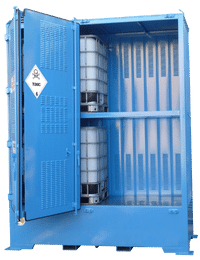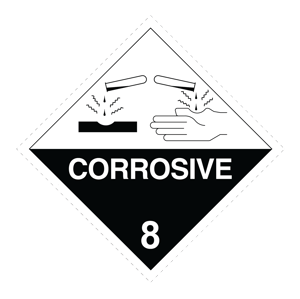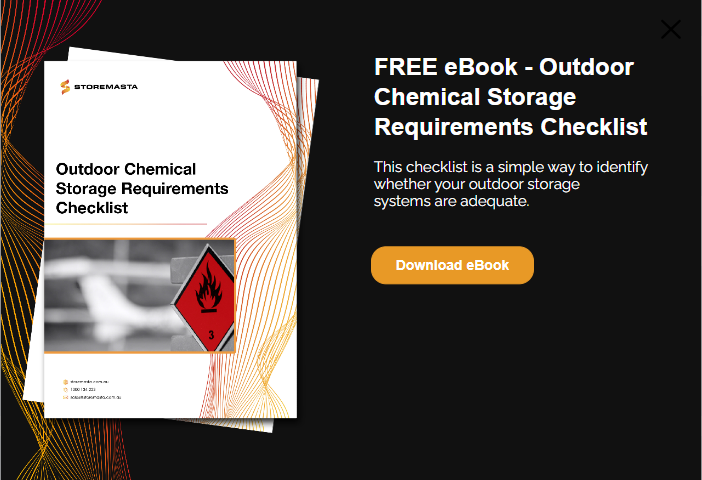One of the considerations you’ll have to make when choosing storage for your dangerous goods, is whether to store your hazardous chemicals in an indoor or outdoor location. There are many factors to consider when making this decision – including the class of goods that you’re storing, the quantities, and the type of storage you’re using, to name just a few. In this blog, we’ll be looking at outdoor dangerous goods storage — and the factors that will dictate your decision when selecting chemical storage containers.
Storing Chemicals Outdoors
Depending on your circumstances, storing larger quantities of dangerous goods may be a safer — or more convenient — option for your organisation.
We suggest conducting a risk assessment to determine if indoor or outdoor storage is the most viable option for your business.

If you’re considering your outdoor dangerous goods storage needs, we strongly recommend conducting a risk assessment.
Factors to consider may include:
- Aggregate chemical quantities – what is the total amount of hazardous chemicals that you’re storing
- Capacity of your cabinets – some Dangerous Goods classes have additional requirements for larger cabinets
- Location of the cabinet/s – installation requirements may be dictated by emergency evacuation requirements
- Provision for emergency decontamination facilities – you may be required to provide eyewash and/or safety showers for your stores
- Isolation from ignition sources – if you’re storing flammable and combustible liquids, you’ll need to isolate stores from ignition sources by a distance of at least 3 metres
- Segregation from incompatible substances – most Dangerous Goods classes have strict segregation requirements which must be followed to avoid chemical reactions
- Ventilation requirements – if your chemicals emit hazardous vapours that exceed the levels set by the Workplace Exposure Standards, then mechanical ventilation or an outdoor store may be required
IMPORTANT: The Australian Standards details the requirements for indoor chemical storage in safety cabinets. If you can’t meet the requirements of the Standard, ie. Your exceeding the maximum aggregate quantity of chemicals for storage in indoor safety cabinets, you may have to store your chemicals in an outdoor environment.
If you determine that you can’t store your chemicals safely indoors due to any of these factors, you’ll then have to opt for outdoor chemical storage. But what are the options for outdoor chemical storage and what is the best storage solution for your business?
While custom designed and made storage facilities are found on various industrial and commercial job sites, businesses often select chemical storage containers to store their dangerous goods.
This is generally due to the:
- cost-effectiveness of the storage method
- simplicity of the container installation process
- compliance of the container with Australian Standards

Chemical storage containers are a popular choice for outdoor storage due to their cost-effectiveness, convenience and compliance.
There are a wide range of containers suitable for the storage of chemical packages, drums and IBCs. Let’s now take a look at a few of these container types below.
Types Of Chemical Storage Containers
As we’ve mentioned in the above section, there are storage containers to suit a range of chemical packages, quantities and work practices involving dangerous goods. To help you along with your search for outdoor dangerous goods storage, we’ll now highlight some of the container types and the features that they offer. Chemical storage containers may include options such as chemical drum stores, IBC stores and relocatable dangerous goods containers.
When assessing your needs for outdoor dangerous goods storage, you should consider the following factors:
- The Dangerous Goods class of your chemical (you’ll need to check that the container is compliant)
- What type of package you’re storing (certain containers may be constructed for the storage of drums, IBCs or smaller packages)
- The quantity of chemicals that you’re planning to store (check that your needs are within the capacity rating of your chemical storage container)
- What work practices will occur in or near this store (regularly decanting, pumping or transferring chemicals may influence the type of container that you choose)
Why Shipping Containers Aren’t Suitable For Dangerous Goods Storage
While chemical storage containers are designed to be portable, they must not be confused with shipping or freight containers.
There are many factors which make freight containers an unsafe choice for dangerous goods storage including inadequate provision for:
- Separation
- Segregation
- Ventilation
- Spill containment
Shipping containers, unlike dangerous goods containers, are not equipped with mandatory safety features required for the storage of a particular class of Dangerous Goods. Your container must be able to provide risk control measures to minimise the likelihood and impact of incidents such as fire, explosion, asphyxiation, human harm, property damage and environmental pollution.
Therefore, there are many features that must be present to ensure your dangerous goods container is safe and in full conformance with WHS Regulations and Australian Standards.
Can I Use My Indoor Safety Cabinet Outdoors?
If you’ve purchased an indoor safety cabinet for a particular DG class, there is nothing in the Australian Standards that dictates that you can’t use that cabinet in an outdoor environment. However, you should keep in mind that chemical storage containers are specifically designed to be kept in an outdoor environment.
That means that they are designed and constructed with features that assist with protection from the elements. Containers may be constructed with cambered roofs (for rain run off), cyclone protection (for coastal regions), and extra corrosion protection (for exposed locations). Another benefit of choosing a chemical storage container over an indoor chemical cabinet is that it may be equipped with ISO locking bars to prevent theft and unauthorised entry.
Control Measures Of A Compliant Container
To ensure the highest standards of safety for your organisation, you should always check with your supplier or manufacturer that the chemical container meets all the requirements of the Australian Standards.
If chemical storage containers are constructed in full conformance with Australian Standards, the following control measures will be featured:
Chemical Spill Containment
Storing any quantity of hazardous liquid requires adequate spill containment. However, when choosing to store larger volumes of hazardous liquids, there is an increased risk of a significant chemical spill if spill containment is not provided.
A chemical storage container should be constructed with a liquid-tight spill containment sump in the bottom compound of the container. This sump should be capable of holding the required spill capacity as dictated by the Australian Standard for the dangerous goods that you’re storing.
.jpg?width=300&name=Responding%20to%20a%20flammable%20liquids%20spill%20(1).jpg)
Compliant chemical storage containers will offer adequate liquid-tight spill containment for your particular class of Dangerous Goods.
It’s important that the system is inspected and maintained regularly, with any chemical leaks or spills immediately cleaned out. This allows the spill containment system to function as it should, to full capacity.
Natural Ventilation
As we touched on earlier, ventilation requirements may require your business to choose outdoor chemical storage over indoor storage. Some classes of Dangerous Goods, including flammable liquids, corrosive substances, organic peroxides, toxic substances and oxidising agents, emit large amounts of hazardous vapours which can affect the health of staff, as well as pose an increased fire and explosion risk.
Storing chemicals outdoors provides an unobstructed environment in which hazardous vapours can be dispersed in a safer manner than if they were contained in an indoor environment. Chemical storage containers should be constructed to assist with this ventilation and feature a natural ventilation system, such as two walls of louvres, to provide adequate air flow.
However, you must keep in mind that even outdoor stores of hazardous chemicals may need to be monitored for high concentrations of hazardous vapours. Any concentration of vapours that exceed the Workplace Exposure Standards must be controlled in order to prevent asphyxiation and human harm. Inhalation of dangerous fumes can result in a range of health issues including dizziness, intoxication, respiratory problems and even fatalities.
Keeping the chemical packages clean, maintaining the spill sump, and locating your container is a position away from areas where people may congregate are all things you can do to reduce the presence of hazardous vapours.
Construction Is Resistant To Chemical Attack
Chemical storage containers provide protection for — and from — the dangerous goods that they store. Containers should be constructed in a material that is not subject to chemical attack and that does not react adversely with the stored chemicals.
Sheet steel is often the most practical and durable solution for chemical storage containers, with poly linings inserted in stores that house corrosive substances. This durable design also helps protect the chemicals from impact damage, such as debris which is blown into a worksite during a severe storm.
Separation and Segregation
When storing chemicals outdoors, consideration must always be given to the separation and segregation of chemicals from ignition sources, incompatible substances and protected places.
Some hazardous chemicals, such as flammable liquids, may ignite if enough flammable vapours are emitted in an area that has an ignition source. Other chemicals, such as toxic substances, may have to be separated from protected places. However, almost all classes of Dangerous Goods are subject to chemical segregation requirements. These requirements detail the safe distances for goods to be kept so the different classes of hazardous chemicals don’t mix or cause a reaction.
Isolating and segregating chemicals is an important consideration when choosing a location for your outdoor store. You should refer to the Safety Data Sheet of the chemicals that you’re storing to determine if you need to isolate or segregate your chemicals. For example, flammable liquids are a class which present a range of risks to the workplaces that carry them. So, when you’re selecting a location for your outdoor storage container, you should select a position that is free from ignition sources as well as segregated from other chemicals by a distance of at least 3 to 5 metres. Always refer to the Dangerous Goods Segregation Chart when storing or handling any class of chemicals in your business.
Dangerous Goods and Safety Signage
Every dangerous goods store (regardless of DG class, store size or location) should be clearly marked with the appropriate signage.
Compliant signage will include the dangerous goods diamond for the class of chemicals that you’re storing, as well as any further safety signage that relates to your store.
The below example is the signage required for a container storing corrosive substances:

Having clear and correct signage isn’t just a safety recommendation — it’s a legal requirement under WHS Regulations. Having your stores marked with the appropriate signage allows your staff, supervisors, contractors or visitors to be warned about the potential hazards associated with that store.
Every organisation that stores dangerous goods is responsible for ensuring that the signage remains visible and is in good condition. If signage on outdoor stores fades, peels off or is damaged, it must be replaced as soon as possible to maintain chemical compliance.
How Are You Storing Your Chemicals Outdoors?
Whether you’re considering an outdoor drum store or a relocatable dangerous goods container, there are a wide range of storage containers that will help you achieve chemical compliance. One of the most important considerations when choosing a container is to ensure that it’s designed and constructed to meet the requirements of the Australian Standards. By choosing a container that is compliant, you’ll be taking the necessary steps towards improving the safety of your dangerous goods storage and handling areas.
If you’d like to learn more about storing hazardous chemicals in the outdoor environment, we have a simple checklist that can help. Our Outdoor Chemical Storage Requirements Checklist will help you quickly identify whether your existing outdoor storage systems are adequate for your dangerous goods storage needs. Just click on the below image to access your free copy today.
Joining the team as a Dangerous Goods Storage Consultant, Melissa Hampton became Storemasta's Marketing Manager in late 2021. With extensive knowledge and experience in chemical compliance, Melissa is responsible for leading the Marketing team and helping shape their marketing strategy. In her spare time, you can find Melissa hiking, swimming and enjoying the great outdoors in beautiful north-west Tasmania.

